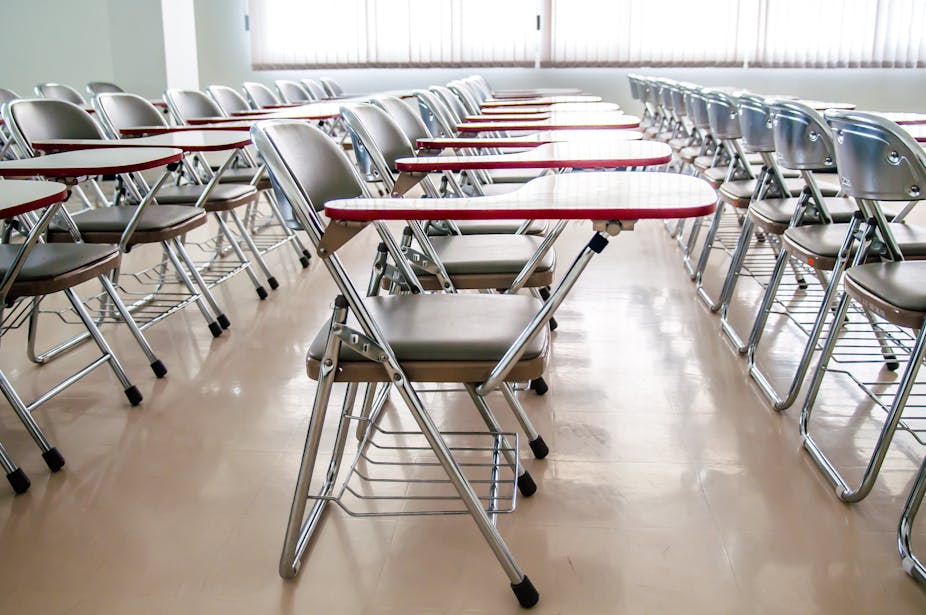New international test results in reading, science and maths show that Australian education is going backwards – a declining trend that has been going on for the past decade.
The 2012 Program for International Student Assessment results (PISA) show Australia performed equal 17th in mathematics, equal 8th in science and equal 10th in reading out of 65 countries and economies.
But the results also see 42% of Australian 15-year-olds failing to meet national minimum standards in maths, and 36% not reaching the same benchmark in reading. In less than a decade, Australian maths literacy performance has declined by the equivalent of more than half a year of schooling.
This is despite the fact that the OECD, the organisation that oversees PISA, has labelled Australia as having a “high quality - high equity” education system, scoring above the OECD average in each of these categories.
With these results it’s hard to see how Australia is high quality or high equity. Is “high-equity” a term you would use to describe a country in which the equivalent of around two-and-a-half years of schooling separates the maths, reading and science scores of students in the highest socioeconomic group and students in the lowest socioeconomic group? Or where significant gaps separate the achievement of students based on their gender, location and cultural background?
Far from being complacent about being categorised as high quality-high equity, these findings show that Australia has cause for concern. The real take-home message from these results is that Australia must do better.
The Council of Australian Governments has set a goal for Australian students to excel by international standards. If this means performing to a standard similar to the top countries like Singapore, Korea, Japan, Hong Kong and Finland then there is some way to go.
Australia’s declining achievement has been fuelled by both a fall in the number of students achieving at higher levels and a rise in the number of students achieving at lower levels. This backwards slide has allowed other countries to leapfrog over us. Poland has been steadily improving since 2000 and is now ahead of Australia in maths, while Ireland has successfully reversed its own downward trend and now outperforms Australia in reading.
In terms of equity, Australia is not achieving its goal of providing all students with similar opportunities to benefit from education, regardless of their gender or background. Australia has slipped backwards to the type of gender disparity that was seen decades ago.
PISA 2012 also shows that Indigenous students, rural students and students from low socioeconomic backgrounds are more likely to achieve at lower levels – and many face the double liability of coming from a disadvantaged background and attending a disadvantaged school.
Australia must strive to improve outcomes for all students – getting the lowest achievers up to an acceptable standard for a wealthy first-world country and extending the higher achievers to lead the country in terms of innovation and development. The goal is attainable, but research into what actually works in changing outcomes is essential.
Improving quality and equity requires a long-term view and a broad perspective. PISA has alerted the Australian school system to a decline in reading literacy achievement and now a significant decline in mathematical literacy achievement.
Australia is already making efforts to improve the quality and effectiveness of classroom teaching for improved student outcomes through work on the Australian Curriculum, national professional standards for teachers and school leaders, coordinated approaches to school improvement that focus on practices that specifically enhance the quality of teaching and learning, and a more fine-grained approach to monitoring school systems in terms of student outcomes through the National Assessment Program – but we need to do more.
To provide more equitable learning opportunities for all students we need to increase social inclusion – and reduce socioeconomic segregation – in our school system. That means ensuring that all of our schools provide high-quality teaching and foster a culture of high expectations for all students, alongside the development of practices to foster excellence in all schools in order to harness the influence of students on each other as a valuable learning resource.
We need to keep our focus on continuous improvement in teacher quality. That includes developing measures to ensure high-quality candidates enter teacher education courses. It also includes the provision of ongoing, high-quality and evidence-based professional learning for teachers, especially in terms of high-level skills in assessment and the analysis of data in order to focus on each student’s learning and the best next teaching steps to advance that learning.
Participation in international studies such as PISA enable us to stop and look at how Australia’s education system “stacks up” against those of other countries – our trading partners and others. The findings of the two most recent studies show that levels of achievement in both reading and mathematics have declined.
The areas of particular concern are clear. If Australia is to fulfil the promise of a world-class education for all students, action needs to be taken now.

